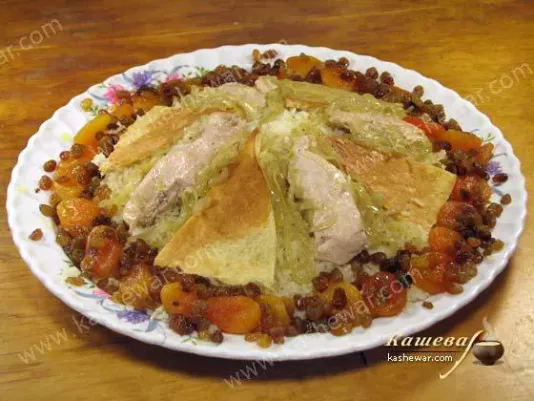Potatoes Stuffed with Chicken
Potatoes stuffed with chicken is a recipe from Azerbaijani cuisine that is prepared for the festive table for Novruz.

Azerbaijani Cuisine impresses with its diversity of flavors, aromas, and ancient culinary traditions passed down through generations. It combines dishes made with meat, fresh vegetables, herbs, and fragrant spices, creating a vibrant palette of national tastes. Azerbaijani cuisine developed under the influence of nomadic customs, Persian and Middle Eastern gastronomy, yet it has preserved unique features specific to this region. At its heart are pilaf prepared in dozens of variations, soups with chickpeas and lamb, juicy kebabs, as well as crispy baklava, shekerbura, and other desserts for which Azerbaijani feasts are renowned. Fragrant tea served with traditional sweets concludes every meal, highlighting the warmth and hospitality of the local culture.
Azerbaijani cuisine features hundreds of national recipes, many of which have become everyday meals not only in the region but also across the diaspora. The foundation consists of meat dishes made from beef, lamb, and poultry. Among the most well-known are dolma (meat with rice wrapped in grape leaves), kufte (large meatballs), piti (meat and chickpeas stewed in a clay pot), bozbash (meat and vegetable soup), lavangi (fish or chicken stuffed with nuts and dried fruit), shorba, and dushbara (tiny dumplings in broth). Pilaf holds a special place – there are at least 40 variations with different fillings: barberry, chestnuts, dried fruits, herbs. All pilafs are prepared separately: the rice is cooked on its own, the garnish is made separately, and the presentation is festive.
Azerbaijanis hold great respect for food. A meal is not only a way to satisfy hunger but also an important social ritual. The table is always rich: various types of bread, herb-filled salads, seasonal vegetables, cheeses, meat dishes, soups, pilaf, sweets, and tea. Dishes are typically served on large shared platters for everyone to help themselves. Tea service is especially important: usually strong black tea in armudu glasses, served with jam, lemon, or sometimes mint. Lavash or thin churek is always served with main dishes. Meals are unhurried – enjoyed with family or guests, accompanied by conversations, jokes, and traditional toasts.
Pilaf occupies a special place in Azerbaijani culinary tradition. It’s not just eaten – it’s celebrated. At its core is long-grain rice (chao or basmati), cooked to a fluffy, tender consistency. Pilaf is served with saffron, clarified butter, and a garnish – which could include meat, nuts, dried fruits, or herbs. A distinct version is shah pilaf, where rice and ingredients are baked in a crisp pastry shell. There are many types of pilaf: turshu, sabzi, kyurma, tiyri, lobya. Every family has its own recipe. Pilaf is a must at weddings, holidays, and family gatherings. Its aroma and appearance create an instant festive atmosphere.
Azerbaijani cuisine relies on fresh, high-quality ingredients. The core elements include vegetables, meat, herbs, legumes, grains, and dairy products. Favorite spices include cumin, barberry, coriander, saffron, thyme, mint, and turmeric. Herbs are used extensively: cilantro, basil, tarragon, dill, parsley, green onions, and radish leaves are served fresh and sometimes even as a side dish. Popular dairy drinks include tan, ayran, and katyk. Vegetables are often baked, stewed, or stuffed. Fruits are used not only in desserts but also in meat dishes. Thanks to the mild climate, many ingredients are seasonal and fresh, ensuring natural flavor and health benefits.
Desserts in Azerbaijan are more than just a sweet ending – they’re a cultural experience. Most sweets have Eastern roots: baklava (nut filling between pastry layers soaked in syrup), shekerbura (pastry filled with nuts and sugar), kyata (a sweet bun with filling), and resht-kulcha. Also popular are fruits in syrup and jams made from rose petals, figs, and walnuts. All of these are typically served with tea – a drink central to any gathering. Azerbaijani tea is always hot, strong, and aromatic. It’s sipped slowly while chatting, welcoming guests, and sharing time. This tradition brings together families, neighbors, and generations.